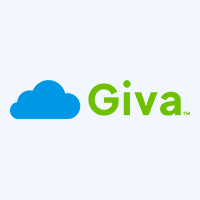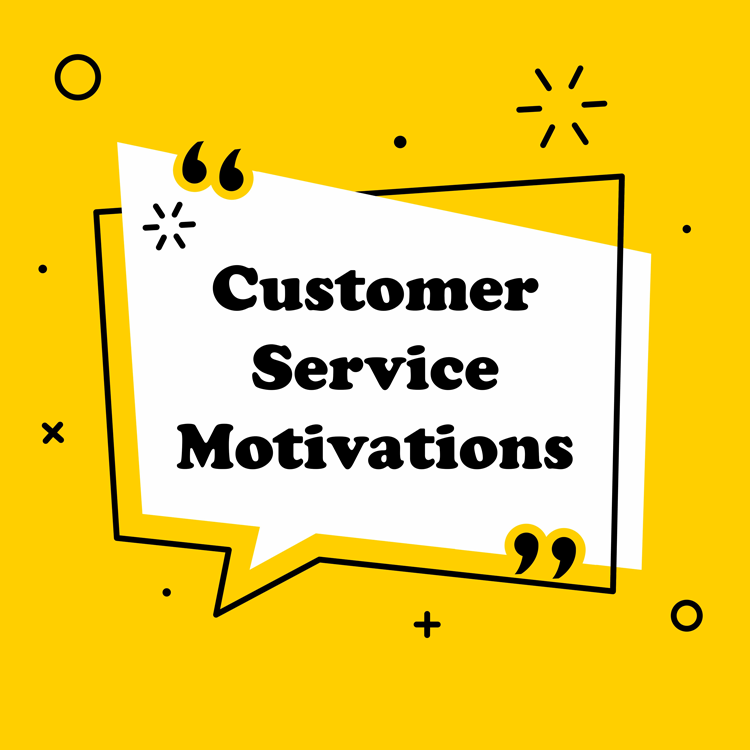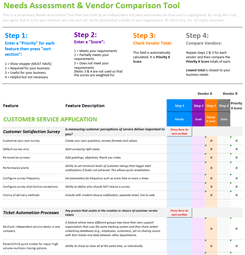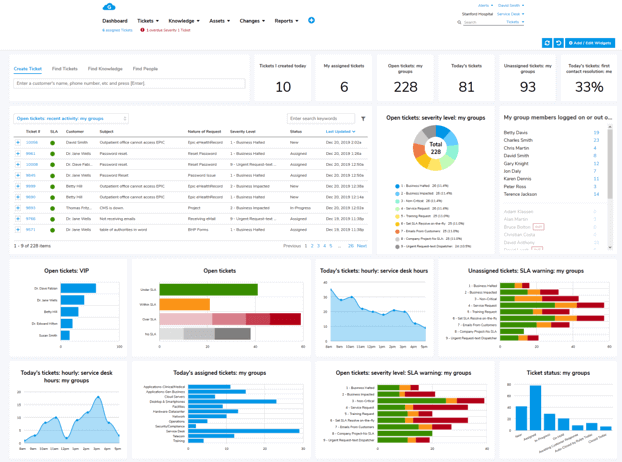16 Top Call Center Outsourcing Companies for 2025
Call center outsource companies are considered one of the most cost-effective ways to ensure an organization's customer service operations are delivered to high standards.
Whether you're overseeing customer service for a large enterprise organization or your startup's growth is accelerating and there's too much work for your team to handle, an outsourced call center provider could be the ideal Customer Experience (CX) solution.
The following is our article on outsourced call center operations, and our list of the top 16 call center outsourcing companies, reviewed and updated from 2024's list for 2025.

Why Outsource Your Call Center Operations
Outsourced customer service is a proven model, with the industry valued at $79.4 billion in 2023 and expected to reach over $205 billion by 2032.
Customer service is too important to get wrong. With the exponential use of social media and other customer service channels, a great percentage of people will walk away into the arms of a competitor after just one negative experience, and then tell all of their friends and family how bad it was. So, it makes sense that outsourced call center providers will do everything they can to retain your customers and provide the best possible customer service on behalf of your brand.
Outsourcing customer service call center operations is more cost-effective than hiring and retaining an in-house team. It's also easier to set up, scale up, and scale back if required.
Top 16 Call Center Outsource Companies for 2025
Here are 16 of the best, most trusted call center outsourcing companies for customer service, Customer Experience (CX), customer success, and inbound and outbound sales operations:
-
TELUS International
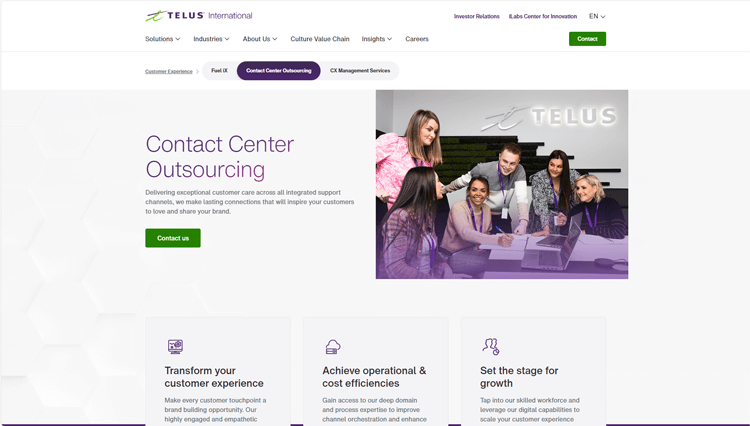
TELUS Digital (formerly TELUS International) is a global provider of outsourced call center services which also includes digital Customer Experience (CX) following the acquisition of outsourcing company VoxPro in 2020.
Pros
- An AI-powered chatbot means that Telus can provide customer service for over 50 CX support languages (500+ data annotation languages and dialects)
- Outsourced customer service in 32 countries covering North, Central and South Americas, as well as Europe, Asia and Africa
- An extensive range of multi-channel and multi-language customer service provisions including a phone-based contact center and digital support
-
Industries served:
- Technology
- Games
- Communications and Media
- Retail & eCommerce
- Fintech and Financial Services
- Healthcare
- Travel & Hospitality
- Automotive
Cons
- The focus on "next-gen" solutions for digital brands means that they might not be suitable for every sector or organization
- More geared towards digital CX and AI-based support than traditional telephony contact center services
Price: Custom pricing, depending on volume and services
-
Sensée
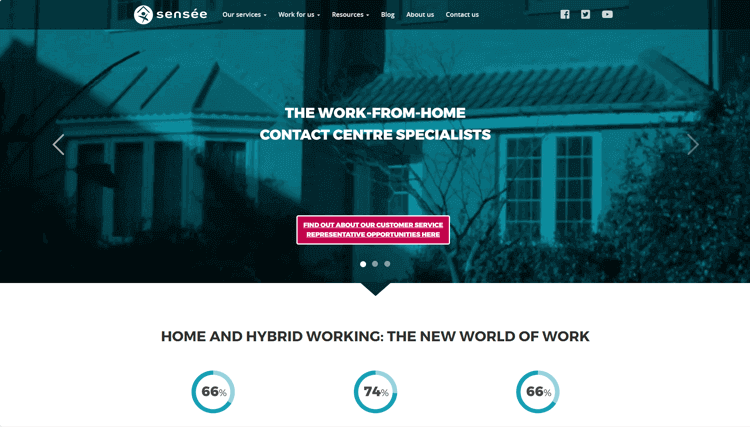
Sensée is a more modern outsourced contact center provider, based in the UK, with a workforce that exclusively works from home (WFH).
Pros
- Agents are on full-time contracts rather than 'gig' or zero-hour contracts, so you can be confident that a higher-quality of service will be provided
- Over 1000 WFH-based contact center agents providing customer services across multiple channels, and they only do this for one client at a time
- Boutique services focusing on quality customer service provisions. ISO27001, PCI-DSS and GDPR compliant, so well suited for the financial or healthcare sectors, as well as others that handle sensitive data
-
Industries served:
- All sectors from Healthcare to Financial to Retail
Cons
- Based in the UK, so might not be ideal given the time zone difference for US organizations (except for looking after your UK customers)
Price: Custom pricing, depending on volume and services
-
Working Solutions
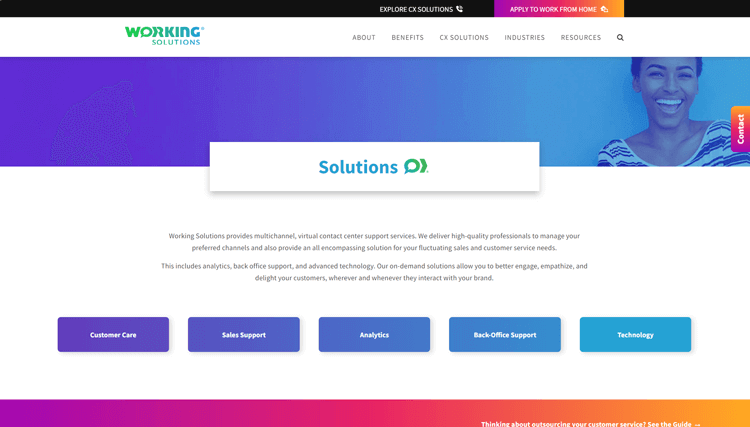
Working Solutions is a multi-channel contact center and CX provider for businesses in North America.
Pros
- Access to over 150,000 staff via Working Solutions Business Process Outsourcing (BPO) service offerings
- Extensive range of services including telephony and Live Chat, and analytics to track agent performance, call volumes, quality, NPS, and SLA adherence
- An online portal for their customers and integrations with your other CX systems
-
Industries served:
- Energy
- Financial
- Healthcare
- Telecom & Media
- Retail & Consumer Services
- Travel & Hospitality
Cons
- An enterprise-centric provider for businesses in the US and Canada; so not ideal for companies worldwide
Price: Custom pricing, depending on volume and services
-
Capita
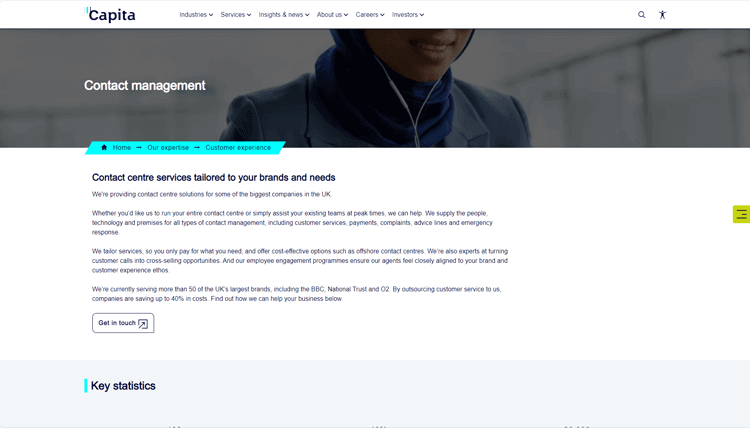
Capita is an outsourcing and BPO giant that handles over 100 million conversations with customers every year, by 41,000 international colleagues. Capita operates in eight countries, serving mainly UK and European clients.
Pros
- Extensive experience in sectors that require the handling of sensitive information, such as the public sector, financial services, and healthcare
- Specialists in remediation, complaints, and collections
- Digital services now provided such as SmartAgent for WhatsApp
-
Areas of focus:
- Central Government
- Local Public Service
- Defence
- Learning
- Fire & Security
- Contact Centres
- Pensions Solutions
Cons
- Operations are in the UK, Europe, India, and South Africa across two divisions: Capita Public Service and Capita Experience, so they might not be suitable for US contact center operations
- An enterprise-centric provider for businesses and government agencies, so not ideal for startups or B2B
Price: Custom pricing, depending on volume and services
-
Global Response
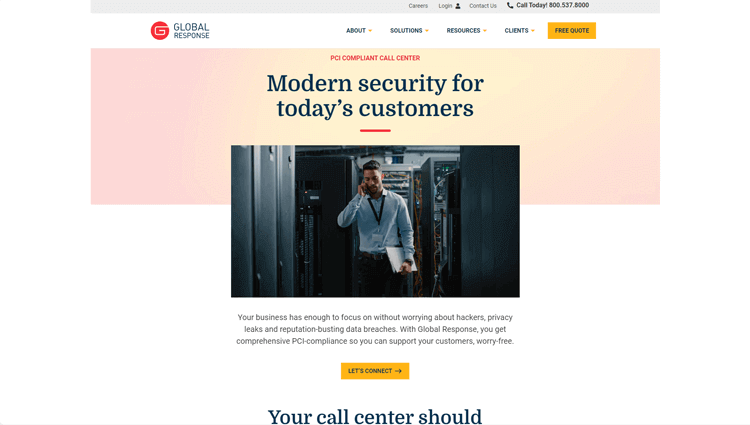
Global Response is an outsourced CX service provider.
Pros
- An award-winning omni-channel, human-first customer experience expert service provider with 40 years of experience
- Multi-channel support in multiple languages and dozens of countries
- Teams positioned to support clients in dozens of sectors in North America, Europe, and Middle East North Africa (MENA)
- HIPAA compliant call center providing ongoing HIPAA training for agents
- PCI compliant
-
Industries served:
- Automotive
- Banking & Financial Services
- Consumer Services
- Education
- Energy & Utilities
- Healthcare
- Retail & Ecommerce
- Travel & Hospitality
Cons
- Services are geared towards large organizations so could be too expensive for startups and even scaleups
Price: Custom pricing, depending on volume and services
-
TeleDirect
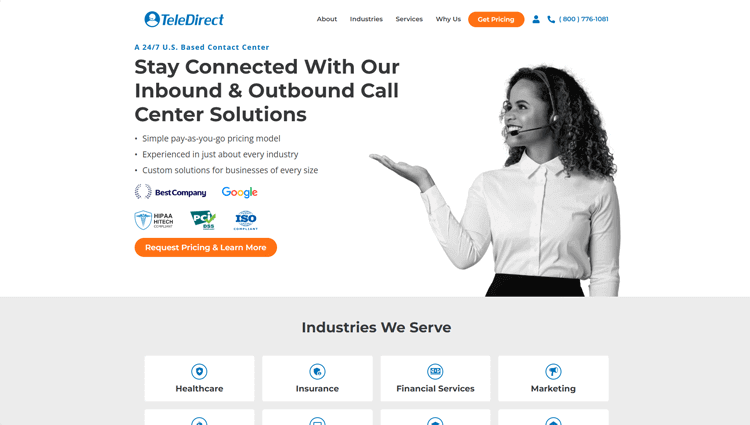
TeleDirect is a US-based, 24/7/365 contact center BPO service provider that has been in business over 60 years.
Pros
- Multi-channel and omni-channel services for customer experience
- Experience across a wide range of industries and sectors
- Pay-as-you-go (PAYG) pricing with no monthly contracts or fees, just pre-paid minute blocks that can be rolled over to the next month for up to two years. Flexibility to up or downsize at any time depending on demand
- US-based headquarters and call center with multi-lingual agents
- Several positive reviews
-
Industries served:
- Healthcare
- Insurance
- Financial Services
- Marketing
- Retail
- Technology
- Education
- Mortgage
- Tax Relief
- Legal
- Accounting
- Government and more
Cons
- Pay-as-you-go (PAYG) pricing could also mean that it could be expensive if you have a surge in customer service contact one month
- Company is US-based with US agents, so not ideal for international clients
Price: Pay-as-you-go pricing, depending on volume and services
-
UpCall
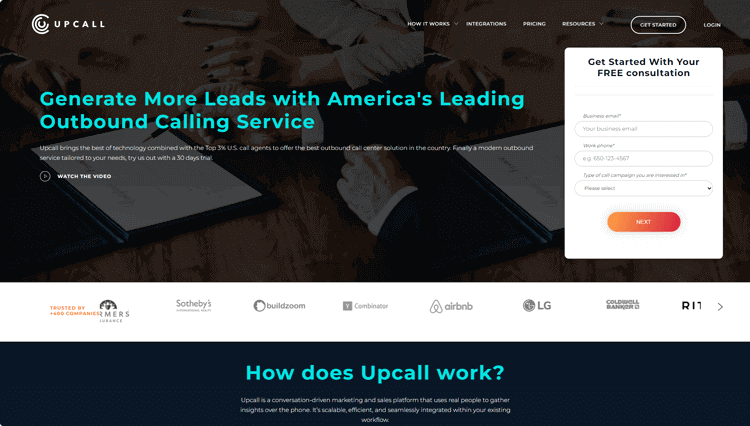
UpCall is a US-based customer service provider that mainly focuses on delivering outbound sales contact center services.
Pros
- An excellent solution with companies that have high-volumes of inbound sales leads
- They combine contact center services with the top 3% of US sales agents to provide sales services and market research for clients
- UpCall could also deliver end-to-end outbound and inbound sales and marketing services
- Integration with over 1,000 apps and tools
Cons
- US-based, so not ideal for businesses in Europe and Asia
- Not suited for those looking for customer service and CX support
Price: Custom pricing, depending on volume
-
LiveOps
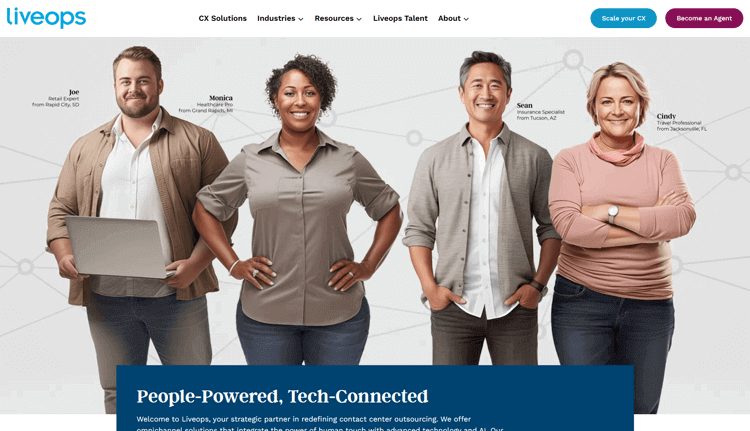
LiveOps is a cloud-based contact center service provider with 20+ years of experience delivering outsourced contact centers for clients. They provide omnichannel customer service solutions that combine human expertise with advanced technology and AI.
Pros
- Over 20 years experience in customer service operations with many enterprise clients
- Omni-channel customer services built for flexibility and scalability, and support for clients through their VirtualFlex platform
- LiveOps delivers high-quality customer service with a robust quality assurance team
- Multiple awards
-
Industries served:
- Healthcare
- Retail
- Insurance
- Energy & Utility
- Government
- Travel & Hospitality
- Communications
- Financial Services
Cons
- A billed-by-the-minute pricing model could be cost-effective but it could mean that your costs could spiral if suddenly you have a lot of customers needing support for one month
- Agents are US-based so this might not work for companies in Europe or Asia
Price: Flexible pricing, billed by the minute
-
Ascensos
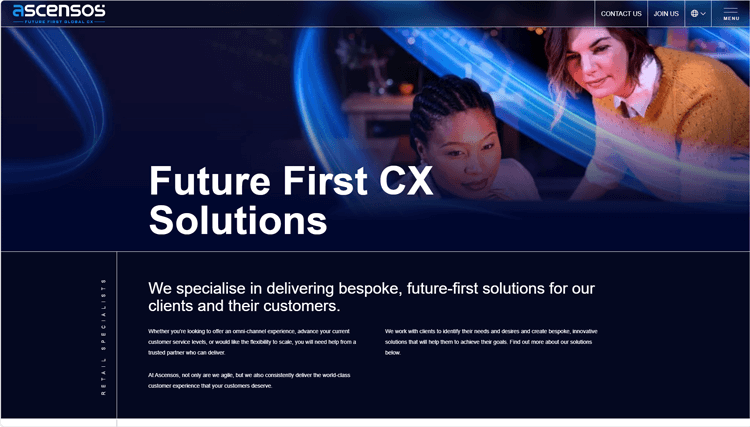
Ascensos a Firstsource company, is a leading UK-headquartered boutique outsourced customer service contact center provider.
Pros
- Contact center services are boutique and tailored around the needs of your business
- Omni-channel and multi-lingual outsourced customer service across phone, chat, text, and social
- Deep customer experience analytics
- Serving in different time zones, cultures and languages, offering flexible and scalable solutions to a pan-European clientele
Cons
- They deploy a 'recruit to fit' model, which means they may not have 'brand ambassadors' suitable for your organization when required
- Likely to be more expensive than other providers due to their tailored approach
Price: Custom pricing, depending on volume
-
Foundever
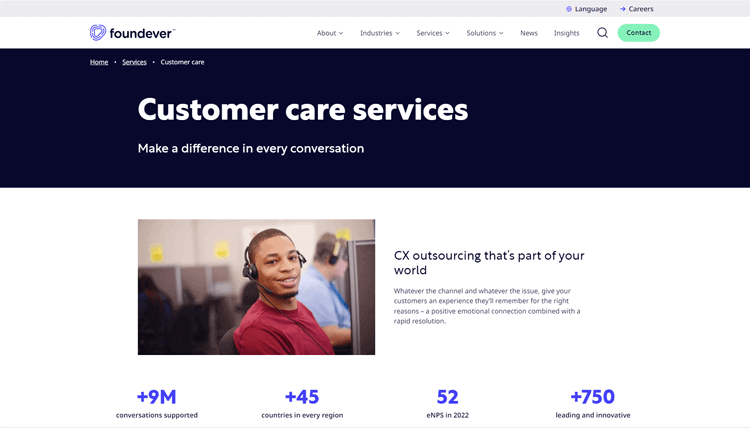
Foundever® is a global outsourced customer service contact center provider that delivers multi-language, multi-region Contact Center as a Service (CCaaS) customer support in 45 countries.
Pros
- Operational since 1994, and it now includes Sitel Group and Sykes Enterprises to guarantee international reach
- Over 150,000 staff in 45 countries with 60 languages supported for telephony and Live Chat customer contact center services
- A flexible, 24/7 talent pool, with extensive experience in a wide range of sectors
- Multiple domestic and international awards and acknowledgements
-
Holds and maintains industry standard security assurance certifications including:
- ISO 27001
- PCI Certification/Compliance/PCI-DSS v3.x
- HITRUST/HIPAA
- SOC Type 1 and 2 Certifications
-
Industries served:
- Banking & Financial Services
- Crypto and Web3
- Disruptors
- Government
- Healthcare
- Insurance
- Manufacturing
- Media Companies
- Retail & eCommerce
- Technology
- Telecoms
- Travel & Hospitality
- Utilities
Cons
- Unlikely to be suitable for smaller companies as these services are geared towards enterprise organizations
- For businesses in traditional industries, this vendor's pivot into digital services might not fulfill their CX needs
Price: Custom pricing, depending on volume
-
Ventrica
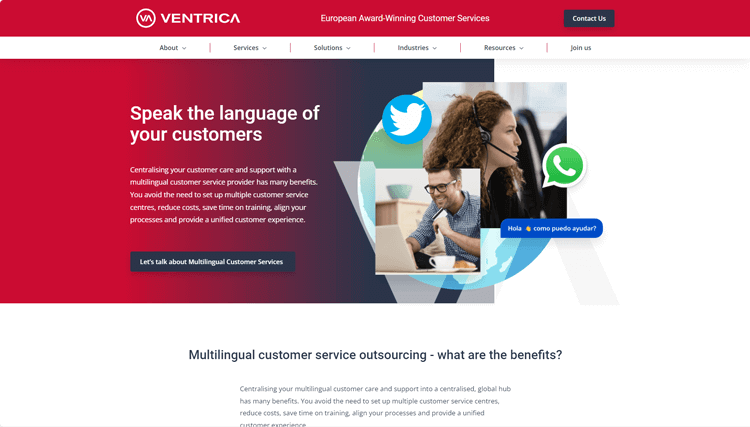
Ventrica provides multi-channel (inbound and outbound calls) and customer services via social media for brands.
Pros
- Experience with some of the world's best-known brands, and an award-winning European CX BPO contact center company
- A multi-layered provision of inbound and outbound telephony, lead nurturing, and social media services. Can also provide outsourced BPO and CX consultancy
- Multiple languages served, with contact centers located in the UK and South Africa
- Internationally recognized for excellence via multiple awards and acknowledgements
-
Languages covered, including but not limited to:
- French
- Italian
- Spanish
- Portuguese
- Dutch
- German
- Polish
-
Industries served:
- Retail
- Food & Drink
- Luxury
- Financial Services (FCA)
- Housing
- Logistics
Cons
- More of a social, "brand advocate" approach than a traditional contact center, so may not be suitable for every type of company and sector
- A medium size organization serving the UK, Europe and now South Africa, not geared toward North America or other regions at this time
Price: Custom pricing, depending on volume and services
-
SupportYourApp
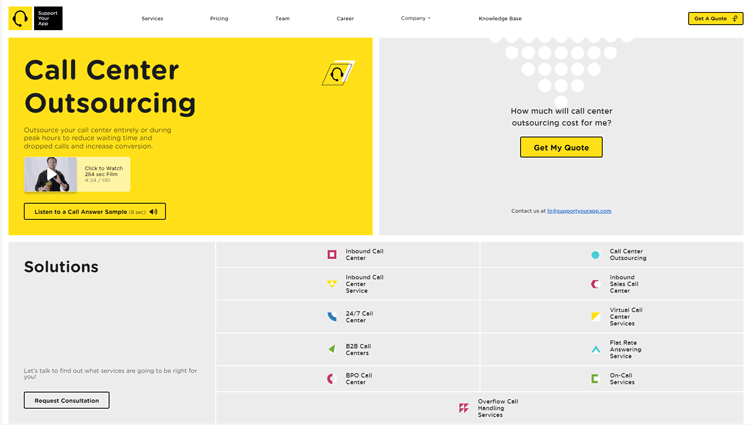
SupportYourApp is a Ukraine-based (with UK and US offices) contact center agency that's ideal for eCommerce and SaaS (Software as a Service).
Pros
- Digital, app-based with AI and Live Chat for SaaS apps, eCommerce stores, and brands that have Amazon and eBay stores
- Social media management services can be delivered by them too
- Inbound and outbound 24/7/365 customer support and even sales-centric services, serving in 60+ languages across major markets
- PCI DSS Level 1 Provider, GDPR and DMCA compliant, ISO 27001 certified
- They have grown to 1,200 agents in 7 international hubs
- Multiple awards and positive reviews
Cons
- More of a social, digital-first approach than a traditional contact center, so may not be suitable for every type of company and sector
Price: Custom pricing, depending on volume and services
-
1840 and Company
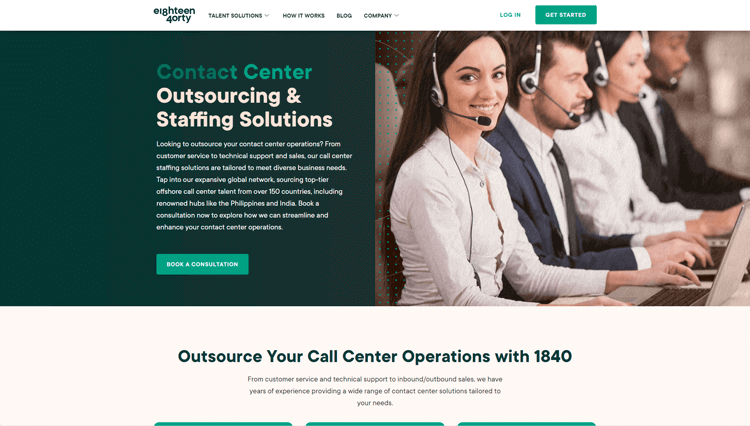
1840 and Company is an outsourced contact center provider.
Pros
- Outsourced customer contact agents in India and the Philippines; ideal for the US and European markets
- Customer service, technical support, and sales services provided
- A 24/7 workforce and AI-powered solutions
- Multiple awards and acknowledgements
-
Industries served
- Healthcare
- Real Estate
- Insurance
- Banking & Finance
- Information Technology
- Retail & eCommerce
- Telecommunications
Cons
- An outsourced or recruitment model means that they don't manage everything in-house, so in some cases you're paying to recruit the agents you need
Price: Custom pricing, depending on volume and services
-
Five Star Call Centers
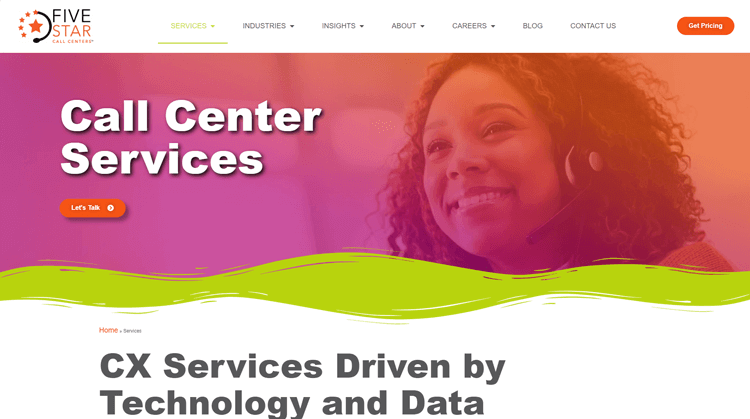
Five Star Call Centers is another outsourced contact center vendor, serving customers for over 35 years.
Pros
- Outsourced 24/7/365 contact center agents in the US and other worldwide locations
- Multi-channel, cloud-based, and now with AI-powered services to more effectively look after customer needs
- Multiple awards, acknowledgements and client testimonials
-
Industries served:
- Product & Technical Support
- Healthcare
- Retail
- Hospitality
- Financial Services
- Government Programs
Cons
- A US-centric company, so may not be suitable for worldwide clients or global brands
Price: Custom pricing, depending on volume and services
-
The SaaSy People
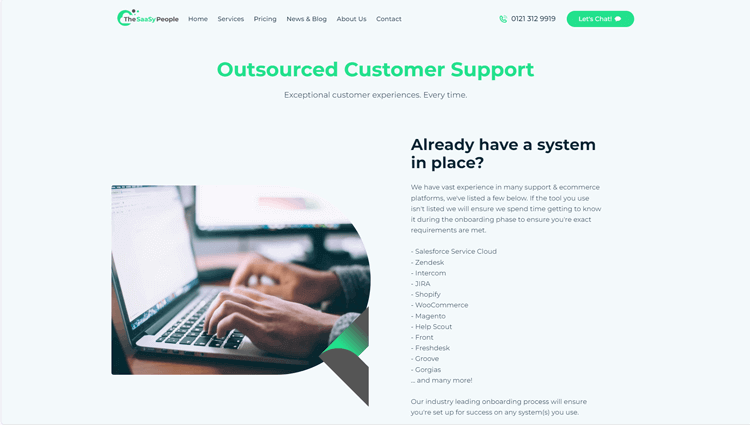
The SaaSy People is a UK-based contact center provider focused on digital sectors.
Pros
- An outsourced telephony and Live Chat provider that's tailored for growing businesses, instead of large enterprise organizations
- Multi-channel and award-winning with an experienced leadership team
- 5-star reviews from staff and former staff on Glassdoor are a good sign that they deliver well internally and, therefore, their staff will deliver well for clients
- ISO 27001 certified
- GDPR compliant
- Best-in-class, cloud based software tech stack to ensure seamless and scalable service delivery
- Multiple awards and acknowledgements
Cons
- UK-based so might not be suitable for US companies
Price: From $1800 per month per agent (on a shared basis)
-
Teleperformance
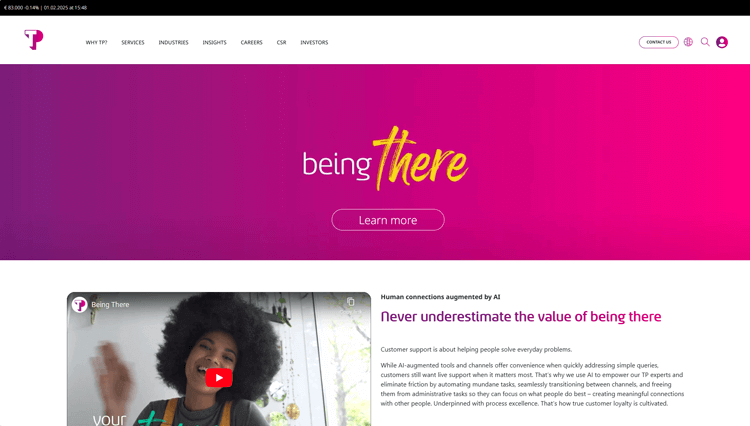
Teleperformance is an international customer experience management company, offering CCaaS to top companies worldwide. Main service regions include USA, Canada, Europe, Asia-Pacific and Latin America providing support in multiple languages.
Pros
- Multiple channels used: voice, email, chat, social media, and video
- 500,000 employees covering 300 languages and dialects, serving 170 markets in 100 countries with an average client relationship of 14 years
- Multiple awards, acknowledgements and certifications
- Ranked fifth among World's Best Workplace™ listed companies which may reflect positively onto client satisfaction
-
Industries served:
- Automotive
- Energy & Utilities
- Media
- Government
- Technology
- Travel, Hospitality & Cargo
- Banking & Financial Services
- Healthcare
- Insurance
- Retail & eCommerce
- Telecom
- Video Games
Cons
- With the sheer magnitude of services provided and number of employees worldwide, consistency of performance and experience may vary
Price: Custom pricing, depending on volume and services
Key Takeaways: Call Center Outsourcing for Streamlined Organizations
Contact center outsourcing companies, whether your business needs agents answering phones or agents responding to Live Chat requests in real-time is a smart way to provide excellent customer service and reduce costs.
With operators in a $100 billion+ market, there are many choices. However, you have to be careful to select the right outsourced contact center service provider for your organization. Providing high-quality customer service is mission-critical for every kind of business, so getting it wrong could prove very costly.
Experience the Giva Call Center Support Software Difference
Giva offers SaaS tools for call center teams and outsourcing companies including:
- Customer Service Software
- Knowledge Management Software
- Highly Customizable and Useful Dashboards
- AI Copilots
Simple, clean design. Transforming everyday customers into raving fans, brand ambassadors and evangelists.
- Deploy in days, train in 1 hour
- Robust, fast and painless reporting for higher-quality decision-making
- Highly customizable without programming or consultants
To learn more, book a free Giva demo to see our solutions in action, or start your own free, 30-day trial today!
